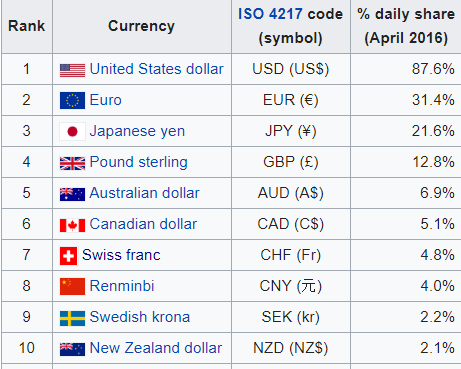FX Currency Pairs: Majors, Minors, Pairs and Crosses
As with any discipline, the world of FX is full of technical terms and jargon, which to the uninitiated can seem a bit daunting and unintelligible.
In this article, we will be demystifying some of that jargon to help you understand what people in the FX market are talking about.
FX Majors
When we talk about FX majors, we’re referring to the currencies of some the world's leading economies, which are also the most actively traded of FX instruments. They combine with other leading currencies to form FX rates, but we’ll go into more detail on this later. The most active of the majors are the EURUSD or eurodollar, USDJPY or dollar-yen and GBPUSD known as cable. Also considered to be FX majors are rates such as AUDUSD, NZDUSD, USDCHF.
The table below shows the daily percentage market share of the individual major currencies based on data from the BIS tri-annual survey, which is known as the FX markets bible. Note that there is some double counting here as the US dollar is involved in the majority of FX transactions.

FX Minors
The minors are FX rates that involve combinations of currencies other than the major rates listed above. They are less actively traded than the major rates, however, they can be comprised of a combination of those major currencies. One example of this is GBPSEK, the rate between the British pound and the Swedish Krona. This is considered to be an FX minor, despite being comprised of two top ten currencies as measured by daily turnover in the BIS data. Other examples of FX minors would be the US dollar vs the Danish Krona (USDDKK) or indeed the Euro versus the South African rand or EURZAR.
Pairs & Crosses
As we noted above, FX rates are made up of two currencies. For example, the US dollar and Japanese yen are the constituents of the dollar-yen Forex rate. The rate expresses the relative value of one versus the other, and the price fluctuates based on changes in perceptions of those values, with the dollar strengthening and yen weakening and vice versa as new information and influences come to light. These rates fall into one of three categories depending on how they are composed.
FX pairs
Generally thought to be those FX rates that contain the US dollar as one of its currencies. The US dollar is the world's global reserve currency its value is the benchmark from which all FX rates are calculated or referenced to. Since the formation of the euro or European single currency, the definition of an FX pair has been modified to include FX rates that contain the euro, although there is still some resistance among purists who prefer to use the traditional definition.
FX crosses
Defined as those rates that do not contain the US Dollar as one of their constituents so, for example, AUDJPY, the Australian dollar vs the Japanese yen, would be considered an FX cross as the dollar plays no direct role in the composition of the rate. However, there is a relationship at work here and the name cross gives us a clue as to what that might be. We can infer what the AUDJPY rate should be by examining the AUDUSD and USDJPY rates and multiplying one by the other (AUDUSD *USDJPY) or if you prefer crossing them to create the third rate in this case AUDJPY. When we reference FX cross rates, we tend to do so using the name of the quote currency so that AUDJPY would be called an Aussie cross alongside standards such as AUDNZD, AUDCAD, AUDZAR and others.
FX exotics
FX exotics are rates which are formed by combining two currencies that would not usually have a natural affinity or at least not a large one. They can often involve currencies from emerging or frontier markets, and while some these rates might seem unlikely combinations, there is usually a reason for their existence. An example of this would be Norwegian krona vs the Thai baht. These two currencies share a relationship through the role of seafood in their respective national economies. The lower we move down this FX hierarchy, the more volatile and less liquid the rates quoted are likely to be which of course makes sense as deep liquidity tends to encourage price stability, while illiquidity means price instability.
For more analysis, you can check out Darren's Daily Market Update (key market news in minutes) or follow him on Twitter.
The information provided here reflects the view of the analyst and does not reflect the opinion of Pepperstone. The information has been provided without any alteration or verification. Pepperstone does not represent that this material is accurate, current, or complete and it should not be relied upon as such. The Information is not to be construed as a recommendation; or an offer to buy or sell; or the solicitation of an offer to buy or sell any security, financial product, or instrument; or to participate in any particular trading strategy. Readers should seek their own advice. Reproduction or redistribution of this information is not permitted.